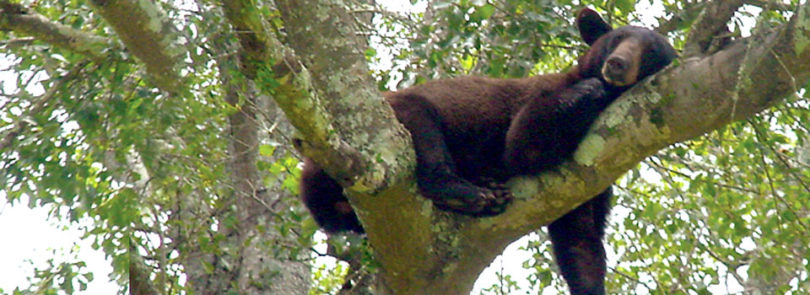Residents of other southern states have expressed negative views about black bears, but a new survey by researchers in UGA’s Warnell School of Forestry and Natural Resources shows that Middle Georgia residents-from Bleckley, Houston, Pulaski, and Twiggs Counties-strongly support efforts to conserve these animals in their part of the state.
Conducted by assistant professor Craig Miller and graduate student Joshua Agee during 2008, the survey was mailed to 4,000 residents, of whom 1,227 responded.
Findings included:
Sixty-one percent of the respondents supported releasing black bears into a sustainable habitat currently devoid of bears.
- Twenty-one percent had seen a black bear in their county between February 2007 and February 2008.
- Sixty percent said they were not concerned about property damage bears might cause, although 69 percent said they would want a bear trapped and relocated if it had tried to enter their homes.
- Eighty-two percent said that seeing wildlife is a positive experience.
The results are a good indicator of how the public will react to efforts to manage the black bear population in the four Middle Georgia counties, said Miller. “We found that when people actually see black bears, they have more support for bear conservation.”
The survey will be used by the Georgia Department of Natural Resources (DNR) to help develop a management plan for black bears in Middle Georgia. But Bobby Bond, a senior wildlife biologist with the DNR, said the agency is awaiting results from other studies-one that puts radio collars on bears to track their movements, another that estimates their population-before proceeding with a plan, which will be overseen by UGA adjunct wildlife professor Michael Conroy.
“This Middle Georgia bear population is a bit under the radar,” Bond said. “The others have been managed.” According to Miller, bears live in three distinct areas of the state: North Georgia, generally north of Interstate-85; the four counties of Middle Georgia; and South Georgia, around the lower sections of the Flint River near the Florida line.
Bear populations across the Eastern United States are up overall, Miller said, and this means not only that they are reappearing in rural areas from which they ‘ve long been absent but also that they’ve sometimes shown up in urban areas.
That’s why it’s important to educate the public about bears and their behaviors, said Miller. People should know, for example, that because “black bears are easily frightened, slamming doors will easily scare them away from yards. And people shouldn’t feed the bears, because the animals will become habituated. Changing human behavior is the easiest way to prevent problems.”





